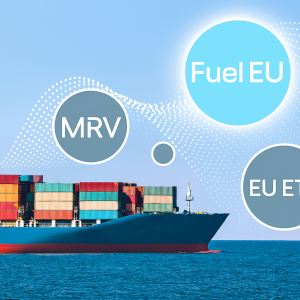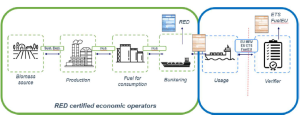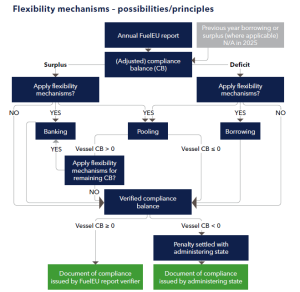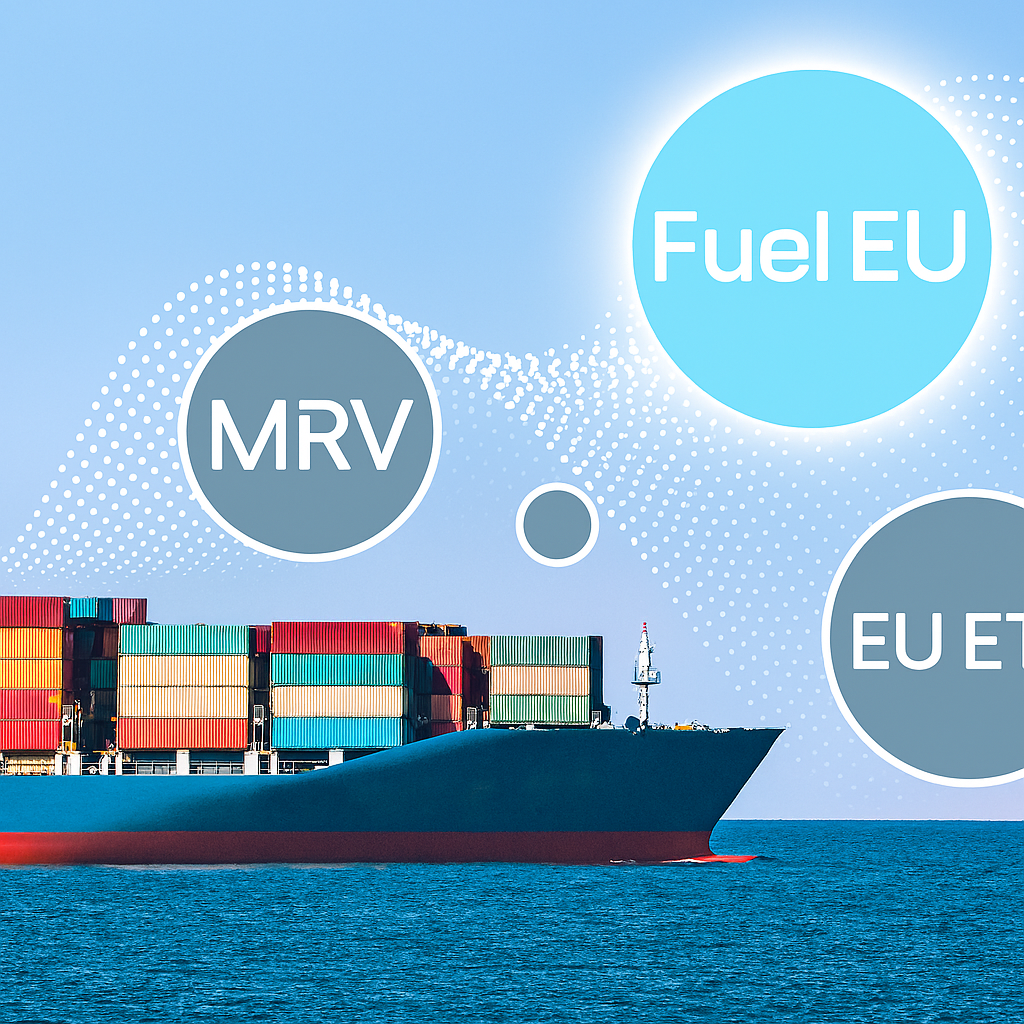07/19/2025

With the implementation of the FuelEU Maritime regulation, numerous questions have arisen regarding compliance—particularly around fuel allocation, certification procedures, methane slip handling, and applicable exemptions. This update provides clarity on these issues in response to industry feedback and aims to help shipowners and operators navigate the new rules effectively.
This update is especially relevant for shipowners, operators, and technical managers seeking to ensure compliance with FuelEU Maritime and the EU ETS.
Latest Guidance on Fuel Allocation and Certification
Two important guidelines have recently been finalized by the European Sustainable Shipping Forum (ESSF) to aid in the regulation’s rollout:
1. Calculation Methodologies under FuelEU Regulation (EU) 2023/1805
The ESSF has released a technical report outlining how to carry out performance calculations in line with FuelEU Maritime requirements. It explains key principles around fuel allocation and provides actionable insights for ensuring compliance during emissions reporting.
Although the illustration referenced here comes from DNV’s white paper on FuelEU Maritime, the methodology aligns with the ESSF’s official documentation. This report also addresses the regulation’s core elements, such as renewable and low-carbon fuel integration, voyage-specific exemptions, and flexibility mechanisms like pooling, borrowing, and banking. Further guidance from the European Commission is anticipated in the latter half of 2025.
2. Marine Fuel Certification Procedures Supporting FuelEU Implementation
The second ESSF guideline addresses certification of sustainable marine fuels, providing a standardized Proof of Compliance (PoC) template. This PoC can substitute for a Proof of Sustainability (PoS) when the same fuel is used by a supplier to meet Renewable Energy Directive targets. If no PoS is available, the PoC format is recommended to meet both FuelEU Maritime and EU ETS documentation requirements.
The document also outlines steps for certifying renewable and low-emission fuels, detailing compliance documentation, traceability measures, and sustainability verification.

Illustration of the most beneficial fuel allocation within the FuelEU energy scope (source: DNV white paper on FuelEU Maritime)
Methane Slip: Default Values and Future Certification Possibilities
Currently, both FuelEU Maritime and EU ETS require the use of default methane slip values categorized by engine type. Although the IMO adopted guidelines for measuring methane slip from LNG engines at MEPC 83 in April, several limitations remain:
-
No clear procedures for onboard emissions monitoring,
-
Lack of standardized test cycles,
-
No mechanisms to assess long-term emissions stability after engine modifications.
To bridge this gap, the European Commission is preparing interim certification protocols based on the IMO framework, with expected publication in the second half of 2025.
FuelEU Report Submission Now Live in Thetis Platform
As of 18 June, the Thetis database—managed by EMSA—has been upgraded to allow FuelEU partial reports. This feature supports verified submissions following a change in vessel ownership or operator. Corresponding updates have also been made on the Veracity platform under DNV’s Fleet Status service, enabling customers to request FuelEU partial report verifications through the portal.
On 24 June 2025, EMSA and DG MOVE hosted a webinar to explain these updates. We recommend viewing the session recording for a deeper understanding of compliance processes and Thetis platform functionalities.
Clarifying Flexibility Mechanisms: Pooling, Banking, and Borrowing
Flexibility options under FuelEU—such as pooling, banking, and borrowing—allow some leeway in managing compliance. However, it’s essential to understand their limitations. For instance:
-
Pooling doesn’t guarantee a zero balance.
-
Surpluses can be banked for future use.
-
Deficits after pooling trigger penalties.
-
Borrowing cannot occur once pooling is applied.
The updated guidance includes diagrams that outline permissible sequences and boundaries within these mechanisms.

Illustration of the FuelEU flexibility mechanisms workflow
EEA Agreement: Delays in Incorporation Affecting Norway and Iceland
FuelEU Maritime has not yet been incorporated into the EEA Agreement. As a result, Norwegian and Icelandic ports are currently treated as non-EU ports. Once adopted, the regulation will apply fully to voyages between EU and EEA ports. However, this change will not be applied retroactively. While EEA Joint Committee meetings are ongoing in 2025, no official incorporation date has been announced.
Understanding Exemptions under FuelEU Maritime
Unlike the EU ETS, the exemptions under FuelEU Maritime are distinct and must be interpreted separately. The regulation includes several categories of exemptions, including:
Outermost Regions (OMRs)
For voyages involving Outermost Regions (e.g., Canary Islands, Azores), only 50% of the voyage energy is counted under Article 2(1)(c). Temporary exemptions have been requested by France, Spain, and Portugal for specific routes in these regions until the end of 2029. Energy consumed during port stays in exempt OMRs is excluded entirely from FuelEU accounting (Article 2(4)).
OMR Voyage Scenarios
-
Scenario 1: A voyage from an OMR port to the U.S. includes 50% of energy under FuelEU rules. A stay in a listed OMR port like Las Palmas is 0% under Article 2(4).
-
Scenario 2: Travel between two OMR ports listed as exempt results in 0% energy inclusion until 31 December 2029.

Examples of different OMR voyage scenarios
Other Exemptions
Member states may also request exemptions for:
- Voyages between small islands (Article 2(3)),
- Voyages under public service obligations (Articles 2(5) and 2(6)).
These too will remain valid until the end of 2029.
Key Recommendations for Shipowners and Operators
-
Harmonize Internal Systems and Contracts
-
Ensure internal reporting and contractual agreements align with FuelEU fuel allocation principles.
-
-
Stay Updated on Regulatory Changes
-
Track developments in methane slip measurement and the inclusion of EEA ports in the regulation.
-
Regularly consult the European Commission’s website and technical updates.
-
-
Ensure Proper Documentation and Reporting
-
Confirm eligibility of alternative fuels by securing PoS or PoC from fuel suppliers.
-
Reflect relevant exemptions in onboard reporting systems.
-
Use tools such as DNV’s Emissions Connect for automated compliance support.
-
-
Clarify Pooling Roles and Responsibilities
-
Define obligations with business partners, especially regarding surplus/deficit ownership and pool administration.
-
References
- DNV Report: FuelEU Maritime: Key updates on fuel certification, methane slip, and exemptions
-
ESSF Marine Fuel Certification Procedures Report
-
ESSF Calculation Methodology Report (Regulation EU 2023/1805)
-
DNV White Paper: FuelEU Maritime – Requirements & Compliance Strategies
-
Thetis Platform Webinar – EMSA & DG MOVE (June 2025)
-
DNV’s Emissions Connect and Methane Slip Services

